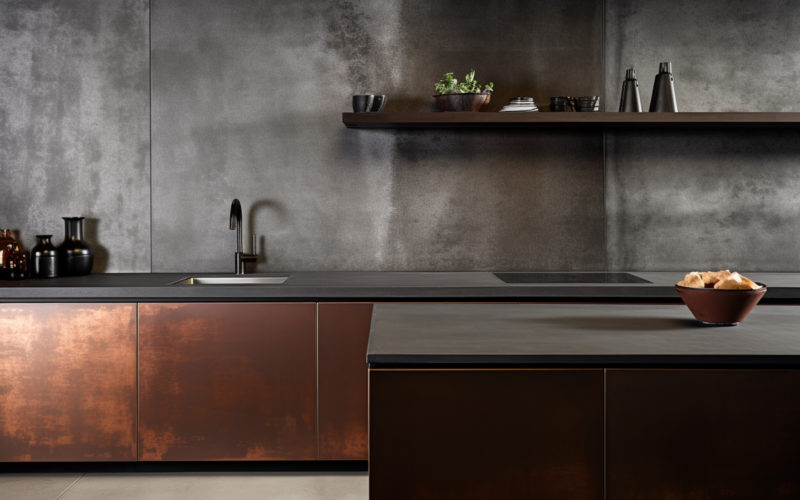Creating a functional kitchen goes far beyond simply selecting beautiful cabinets and appliances. It’s about thoughtfully designing a space that caters to your unique cooking habits, storage needs, and lifestyle.
By prioritizing comfort design, smart storage solutions, and efficient workflow, you can transform your kitchen into a harmonious haven for culinary adventures. Whether you’re planning a complete kitchen overhaul, an upscale kitchen remodel, or just a minor kitchen update, optimizing functionality should be a top priority.
Optimize the Kitchen Work Triangle
The kitchen work triangle refers to the relationship between the three main work areas: the sink, stove, and refrigerator. Positioning these elements correctly is crucial for maximizing efficiency and reducing unnecessary movement in your new kitchen layout.
- Aim for direct, unobstructed paths between the three points of the triangle. No major traffic flows should cross through the work triangle as this can disrupt your workflow.
- Keep the total distance short — ideally less than 26 feet combined for all three legs of the triangle to minimize steps during food prep.
- Avoid corners that are too tight (less than 90 degrees) as they can restrict movement and access to cabinets/appliances.
For maximum efficiency, the work triangle should create a natural, intuitive flow. By optimizing it early in the design process, you’ll minimize obstacles and extra steps. Little disruptions can add up to significant time and energy wasted over years of daily use.
Innovative Storage Solutions
Ample, well-organized storage is key to a functional kitchen. Get creative with vertical storage, deep drawers, pull-out shelves, and hidden compartments to keep your space clutter-free and everything within easy reach during your kitchen renovation.
If you live in the vibrant city of Naperville, renowned for its excellent schools, lush parks, and vibrant community events, a well-planned kitchen remodel Naperville can elevate both your home’s value and everyday living experience. By optimizing the layout and storage from the start, you’ll enjoy a highly functional cooking space tailored to your needs.
Go Vertical
- Install floor-to-ceiling cabinets or shelving units to maximize wall space for storing lesser-used items up high.
- Use pull-out vertical racks inside cabinets for trays, cutting boards, and bakeware to avoid awkward stacking/unstacking.
Drawers vs. Cabinets
- Deep drawers are ideal for pots, pans, and large appliances as they glide out fully for easy access without bending.
- Cabinets with adjustable shelves work better for dishes, glassware, and dry goods to accommodate varying heights.
Hidden Storage
- Add a built-in hutch, credenza or banquette with hidden storage beneath the seats for extra pantry space.
- Utilize toe-kick drawer space near the base of cabinets for lesser-used items you still want accessible.
- Install a pull-out pantry cabinet or lazy Susan in corner cabinets to eliminate blind, hard-to-reach spots.
No more frantic searches! Keeping items organized and within easy grasp makes cooking smoother and more enjoyable in your refreshed kitchen.
Energy-Efficient Appliances
Choosing energy-efficient kitchen appliances not only lowers your utility bills but also reduces your environmental impact. When selecting new appliances during a major kitchen remodel, look for the blue ENERGY STAR® certification and consider:
- Size: Match appliance capacity to your household’s actual needs to avoid wasted energy heating/cooling space you don’t require.
- Smart Features: Models with sensors and auto-adjustment capabilities precisely optimize energy usage for the operation at hand.
- Induction Cooktops: Induction technology heats cookware rapidly using electromagnetic energy while the surface stays cooler – improving energy efficiency up to 25 – 50% over gas or electric resistance elements.
Modern kitchen appliances have come a long way in marrying efficiency with high-performance and tech-savvy features like LED displays, wireless connectivity, and advanced sensors. Investing in the right models will boost functionality and energy savings in your new kitchen.
Durable, Low-Maintenance Materials
Your choice of countertop and flooring materials significantly impacts the longevity and maintenance requirements of your kitchen – areas that see heavy daily use and abuse. When planning a custom kitchen remodel, splurge on quality, hardworking materials.
Countertops
- Quartz and granite are extremely durable, stain and heat-resistant options that won’t easily scratch, etch or stain with acidic foods.
- Solid surface countertops are seamless and non-porous for easy cleaning and resist bacteria growth.
- Concrete, stainless steel and butcher block add industrial flair suited for serious home chefs and withstand tough demands.
Flooring
- Luxury vinyl plank or tile flooring provides highly water-resistant, cushioned, easy-to-clean surfaces that replicate wood or stone aesthetics – great modern kitchen flooring ideas.
- Ceramic or porcelain tiles are also water and stain-resistant with endless style options if you don’t mind a harder surface.
- Concrete floors offer exceptional durability in a seamless surface with the option to add radiant in-floor heating for toasty toes.
When prioritizing function over aesthetics, materials like these allow you to create a hardworking kitchen that looks beautiful for years with little maintenance required.
Optimize Lighting and Ventilation
Good lighting and ventilation are often overlooked yet critical components of a well-designed, highly functional kitchen that keep the space bright, comfortable, and odor-free — key factors to consider with any kitchen backsplash update or full remodel.
Task Lighting
- Install under-cabinet lighting to properly illuminate work surfaces and minimize dangerous shadows when using sharp knives.
- Use pendant or track lighting over islands and peninsulas to focus bright light where you need it most during prep work.
- Invest in dimmable fixtures to set the perfect level of task lighting for various cooking needs or create soft ambient lighting for dining/entertaining.
Ventilation
- A high-quality range hood vented directly outside is a must-have for removing smoke, grease, odors, heat and moisture.
- Add supplemental wall or ceiling exhaust fans to further improve air circulation and reduce stuffiness in the kitchen.
Proper lighting enables safe food prep while effective ventilation keeps the air fresh and clean — a winning combination for an enjoyable cooking experience with peak visibility in your updated space.
Optimize for Ergonomics
When designing your new kitchen layout, keep ergonomics top of mind to reduce strain, increase safety and maximize comfort during food prep and cooking. Key areas to focus on:
Countertop Height: The standard 36″ counter height works well for most adults, but adjust higher (up to 42″) or lower as needed based on the user’s height.
Counter Depth: Allow for 24-30″ of unobstructed counter frontage, especially around the range and sink where you’ll be working most.
Appliance Positioning: Raise the oven, microwave, and other frequently accessed items to between countertop and eye level to avoid excessive bending or reaching up high. Built-in appliance garages can help with this.
Non-Slip Flooring: Choose textured tiles or resilient flooring materials with some grip to increase traction and help prevent slips/falls – especially important with kids/elderly in the home.
Taking the time to customize these ergonomic details when planning your kitchen remodel creates a user-friendly space you can work in comfortably for years without aches and pains.
Make the Most of Small Spaces
If working with limited square footage during a small kitchen remodel, focus on maximizing every inch through strategic space planning and smart layout choices. Some top tips:
Compact Appliances: Invest in slimline or 24″ appliance models made specifically for smaller kitchens to free up space.
Multipurpose Furniture: Use a rolling kitchen cart or folding breakfast nook table that folds down flat against the wall when not in use.
Open Shelving: Replace some upper cabinets with floating shelves to create an airy, open look and increase visible space.
Leverage Natural Light: Install larger windows or a skylight to make the limited square footage feel more expansive and inviting.
Use Light Colors: Pale tones on walls, cabinets, and floors help reflect light and create an illusion of spaciousness in a compact footprint.
Even the tiniest galley or efficiency kitchen can feel incredibly functional when thoughtfully designed with organization and creative space-saving solutions in mind.
Comparison: Popular Kitchen Layouts
The layout you choose impacts traffic flow, accessibility, and overall efficiency – a key consideration for any kitchen remodel to maximize the ROI. Here’s how the most common options stack up:
| Layout | Ideal For | Pros | Cons |
| L-Shaped | Small to medium kitchens | Good workflow, flexible design | Potential for traffic through work triangle |
| U-Shaped | Medium to large kitchens | Plentiful storage and counter space | Potential workspace issues in corners |
| Galley | Small, one-wall kitchens | Efficient workflow, space-saving | Limited counter space, traffic obstacles |
| Island | Open concept kitchens | Additional workspace, social aspect | Requires ample room for clearance |
Frequently Asked Questions
What’s the most efficient kitchen layout?
There is no one-size-fits-all solution as efficiency depends on your space and cooking habits. However, the galley and U-shaped layouts generally provide the most direct, unobstructed workflows. An L-shaped layout with an island can also maximize functionality.
How can I update my kitchen without a full remodel?
Simple renovations like new cabinet hardware, a tile backsplash, and fresh paint or countertops can instantly modernize and increase functionality without breaking the bank. Rearranging your layout may also be possible by reconfiguring cabinet and appliance placement.
How do I choose the right kitchen contractor?
- Get quotes from 3-4 reputable contractors and compare pricing, timelines and included services.
- Check online reviews and ask for references from their recent projects.
- Ensure they are licensed, bonded and insured.
- Have a clear payment schedule and contract stipulating all material and labor details.
Taking the time to vet contractors thoroughly helps ensure your remodel goes smoothly.
Design Your Dream, Hard-Working Kitchen
Designing a functional kitchen goes beyond just aesthetics. By considering your workflow, storage solutions, and appliance placement, you can create a kitchen that makes cooking a pleasure and efficiently meets your needs. Don’t be afraid to break away from old design rules and prioritize functionality for a kitchen that truly works for you.












